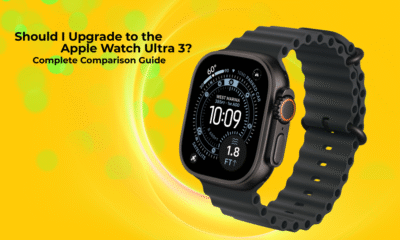Head to Head Battle
Head To Head Battle: Apple AirPods Max VS. Bose QuietComfort Ultra
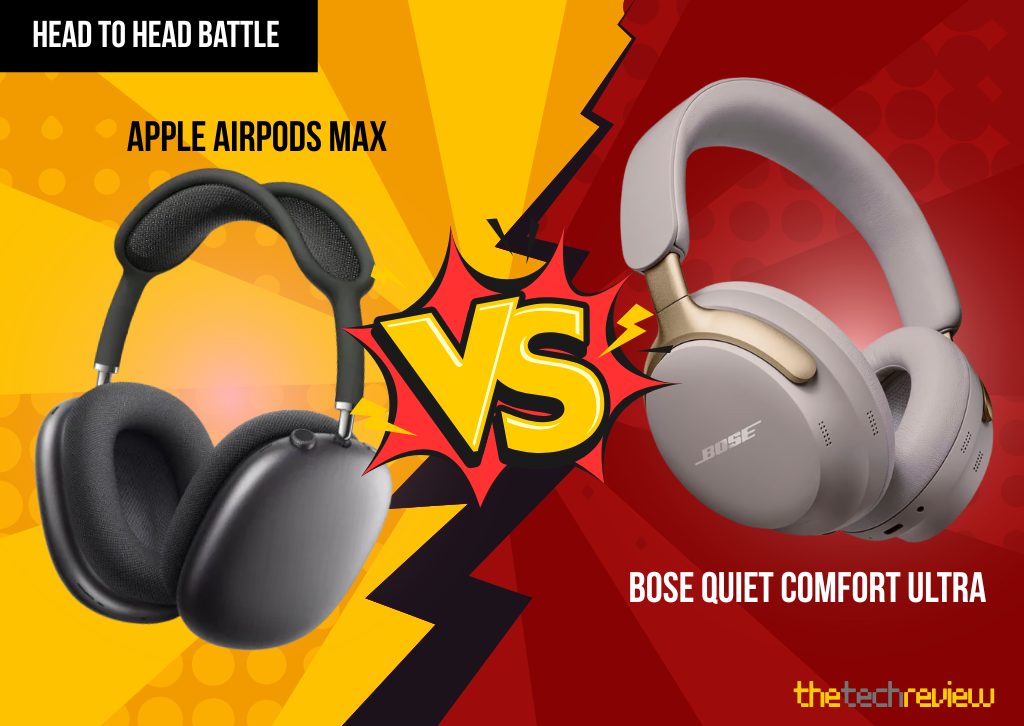
Apple AirPods Max VS. Bose QuietComfort Ultra Let the Battle Begin
The Premium Headphone Arena Clash!
In the realm of premium noise-canceling headphones, two titans consistently vie for the top spot: Apple with their luxurious AirPods Max and Bose, renowned for their audio prowess, with the QuietComfort Ultra. Both promise exceptional sound quality, world-class noise cancellation, and a premium listening experience. But which of these over-ear heavyweights truly reigns supreme? This head-to-head battle will delve deep into their features, performance, and design to help you decide which pair deserves a place over your ears.
Apple AirPods Max Deep Dive: A Statement in Sound and Style
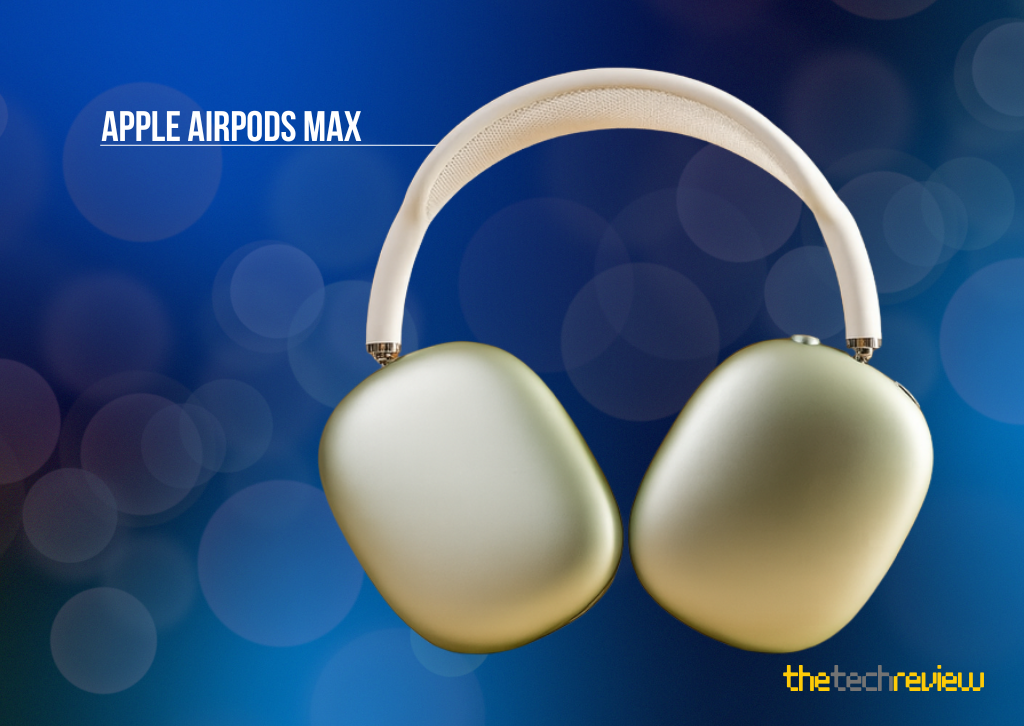
The Apple AirPods Max made a bold entrance into the headphone market with its distinctive design and premium price tag. Crafted with a stainless steel headband, breathable knit mesh canopy, and anodized aluminum earcups, the AirPods Max exude a sense of luxury. The digital crown, reminiscent of the Apple Watch, provides precise control over volume and playback. Sonically, they deliver rich, detailed audio with a balanced sound signature. Spatial Audio with dynamic head tracking offers an immersive listening experience for compatible content. Industry-leading Active Noise Cancellation (ANC) effectively silences the outside world, while Transparency mode allows you to hear your surroundings when needed. Seamless integration within the Apple ecosystem is a major draw, with effortless pairing and device switching.
- Pros:
- Premium design and build quality.
- Exceptional sound quality with detailed audio.
- Industry-leading Active Noise Cancellation.
- Immersive Spatial Audio with dynamic head tracking.
- Seamless integration with Apple devices.
- Effective Transparency mode.
- Cons:
- High price point.
- Relatively heavy.
- Unique Smart Case offers minimal protection and doesn’t fully power off the headphones.
- Limited codec support beyond AAC and SBC.
Bose QuietComfort Ultra Deep Dive: Legendary Noise Cancellation Evolved
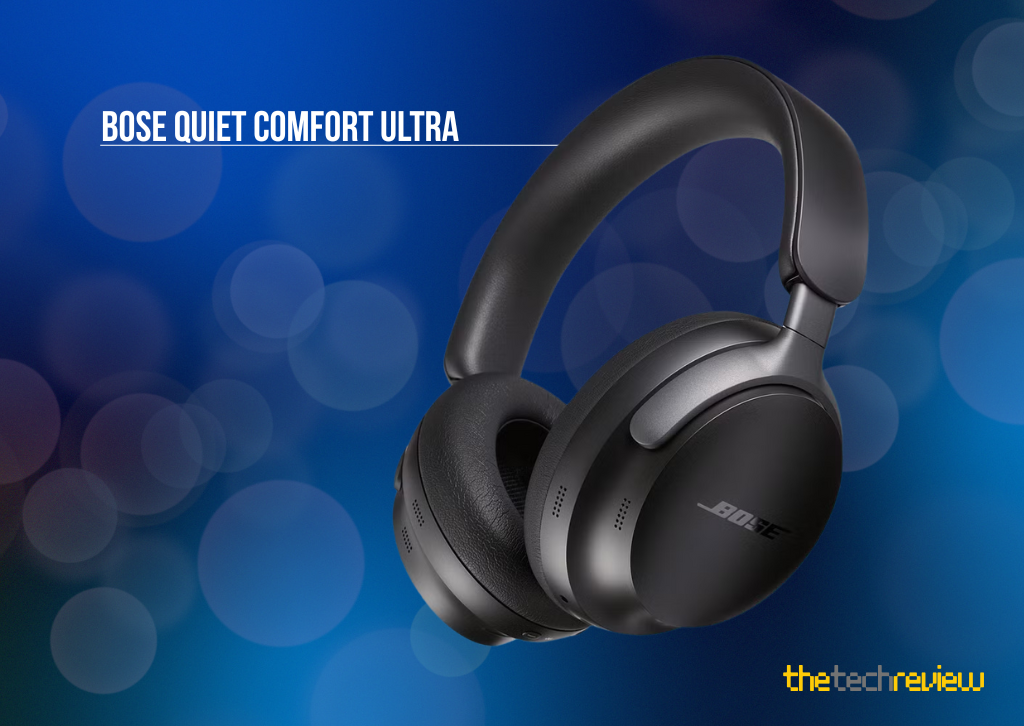
Bose has long been a leader in noise cancellation, and the QuietComfort Ultra represents the pinnacle of their technology. Sporting a sleek and comfortable design with plush earcups, these headphones are built for extended listening sessions. Bose Immersive Audio provides a spatial sound experience that feels natural and engaging. The standout feature remains their world-class noise cancellation, which effectively eliminates a wide range of ambient sounds. The audio quality is characterized by a balanced and refined sound signature, delivering clear highs, detailed mids, and a rich bass. Intuitive touch controls on the earcup allow for easy management of music and calls. Multi-point Bluetooth connectivity enables seamless switching between devices.
- Pros:
- World-class noise cancellation.
- Comfortable for long listening sessions.
- Balanced and refined sound quality.
- Intuitive touch controls.
- Bose Immersive Audio for spatial sound.
- Multi-point Bluetooth connectivity.
- Cons:
- Design might feel less premium compared to the AirPods Max for some.
- Spatial audio implementation might not be as deeply integrated as Apple’s.
- Carrying case, while protective, is functional rather than luxurious.
Head To Head Comparison Chart
| Feature | Apple AirPods Max | Bose QuietComfort Ultra |
| Design & Build | Premium (Steel, Aluminum, Mesh) | Sleek & Comfortable (Plastics, Leatherette) |
| Comfort | Comfortable, but can feel heavy | Very Comfortable for long wear |
| Sound Quality | Rich, Detailed, Balanced | Balanced, Refined, Clear |
| Noise Cancellation | Industry-Leading | World-Class |
| Spatial Audio | Spatial Audio with Dynamic Head Tracking | Bose Immersive Audio |
| Controls | Digital Crown, Buttons | Touch Controls |
| Battery Life | Up to 20 hours (ANC/Transparency) | Up to 24 hours (ANC), 18 hours (Immersive) |
| Bluetooth | Bluetooth 5.0 | Bluetooth 5.3 |
| Codecs | AAC, SBC | SBC, AAC, aptX Adaptive |
| Multipoint | No | Yes |
| Carrying Case | Unique Smart Case (minimal protection) | Protective Hard Case |
| Price | Higher | Slightly Lower |
| Apple Ecosystem | Seamless Integration | Good Connectivity |
Conclusion: A Clash of Audiophile Credentials
Both the Apple AirPods Max and the Bose QuietComfort Ultra represent the pinnacle of premium wireless headphones, each excelling in key areas. The AirPods Max boast a truly luxurious design, exceptional sound quality with immersive Spatial Audio, and seamless integration for Apple users. However, their high price and weight might be a deterrent for some.
The Bose QuietComfort Ultra, on the other hand, continues Bose’s legacy of outstanding noise cancellation and offers a supremely comfortable fit for extended listening. Their refined sound quality and the addition of Bose Immersive Audio provide a compelling alternative. The inclusion of multipoint Bluetooth and a slightly more accessible price point further enhance their appeal.
Crowning the Winner: It Depends on Your Priorities
There isn’t a single definitive winner in this head-to-head battle, as the best choice depends on individual priorities and preferences:
- For Apple Loyalists and Design Enthusiasts: If you are deeply invested in the Apple ecosystem and value a striking design and seamless integration, and budget is less of a concern, the Apple AirPods Max might be the winner for you.
- For Ultimate Comfort and Noise Cancellation Prowess: If all-day comfort and the absolute best noise cancellation are your top priorities, coupled with excellent sound quality and a slightly more approachable price, the Bose QuietComfort Ultra takes the crown.
Ultimately, both headphones offer a fantastic listening experience. Consider your specific needs and what features matter most to you when making your decision in this high-stakes headphone showdown.
Read our full Bose Quiet Comfort Ultra Review here.

Head to Head Battle
Head-to-Head: Bose Ultra Open Earbuds vs. Apple AirPods Pro 2
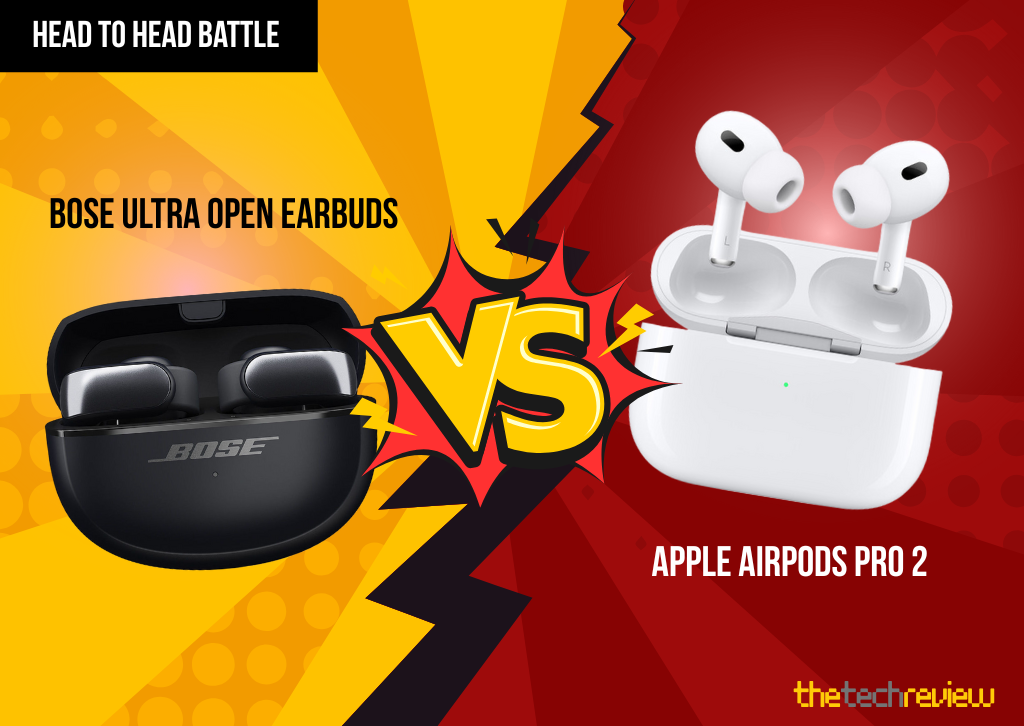
Bose Ultra Open Earbuds vs. Apple AirPods Pro 2
In the world of premium true wireless earbuds, two of the biggest names are battling it out with two very different philosophies. The Apple AirPods Pro 2 are the reigning champions of the in-ear experience, while the Bose Ultra Open Earbuds introduce a groundbreaking, open-ear design. This head-to-head comparison will help you decide which is the right fit for your listening lifestyle.
The Core Difference: Open vs. In-Ear Design
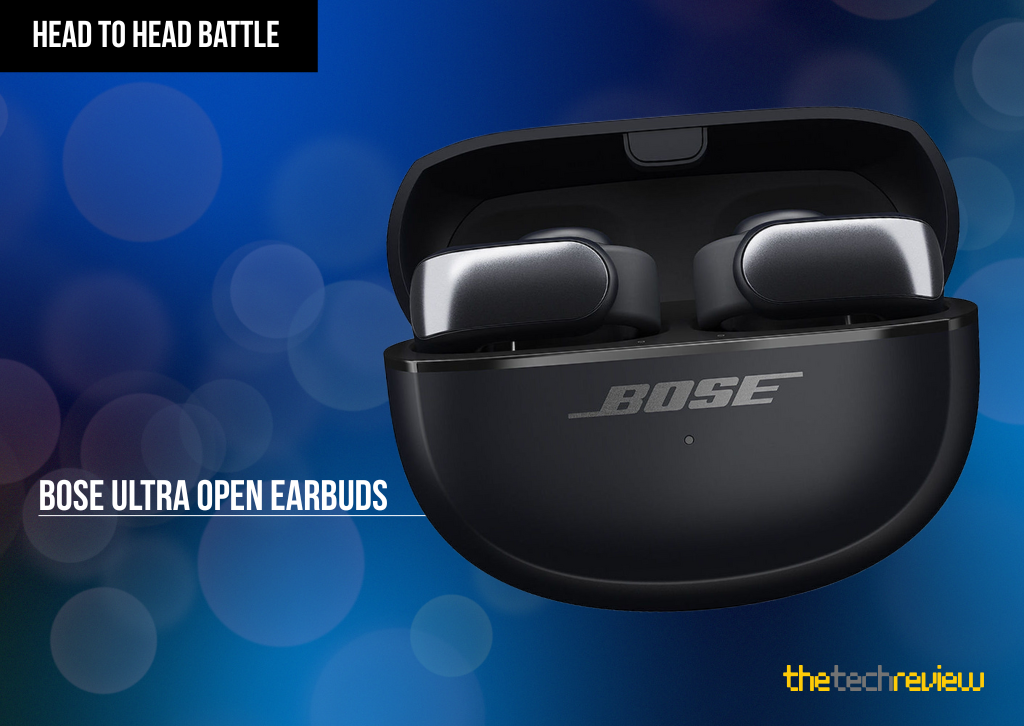
The most significant distinction between these two products lies in their fundamental design.
- Bose Ultra Open Earbuds: These earbuds feature a unique “open-ear” design. Instead of being inserted into your ear canal, they have a cuff-like fit that clips onto the outside of your ear. The sound is directed into your ear without blocking it off, allowing you to hear both your audio and the world around you. This is ideal for those who prioritize situational awareness and all-day comfort, as there is no pressure or irritation from a silicone tip.
- Apple AirPods Pro 2: The AirPods Pro 2 use a traditional in-ear design with silicone tips that create a seal in your ear canal. This seal is crucial for their signature features, including Active Noise Cancellation (ANC) and immersive, high-fidelity sound. The in-ear design provides a more private and focused listening experience.
Audio Quality and Features
- Bose Ultra Open Earbuds: Given their open-ear design, the sound quality is impressive. Bose’s “OpenAudio” technology and a proprietary transducer project rich, private sound toward your ear. While the bass frequencies are a compromise compared to in-ear buds, the spatial audio and head-tracking features create a surprisingly surreal and immersive soundstage. The lack of a seal means there’s no noise isolation, which is a deliberate design choice.
- Apple AirPods Pro 2: The AirPods Pro 2 are renowned for their exceptional audio performance. The H2 chip and custom drivers deliver a rich, well-balanced sound with a strong and satisfying bass response. Features like Adaptive EQ and Personalized Spatial Audio with dynamic head tracking further enhance the audio experience. Most notably, they offer powerful Active Noise Cancellation and a highly effective Adaptive Transparency mode, which allows you to hear your surroundings without removing your earbuds.
Comfort and Fit
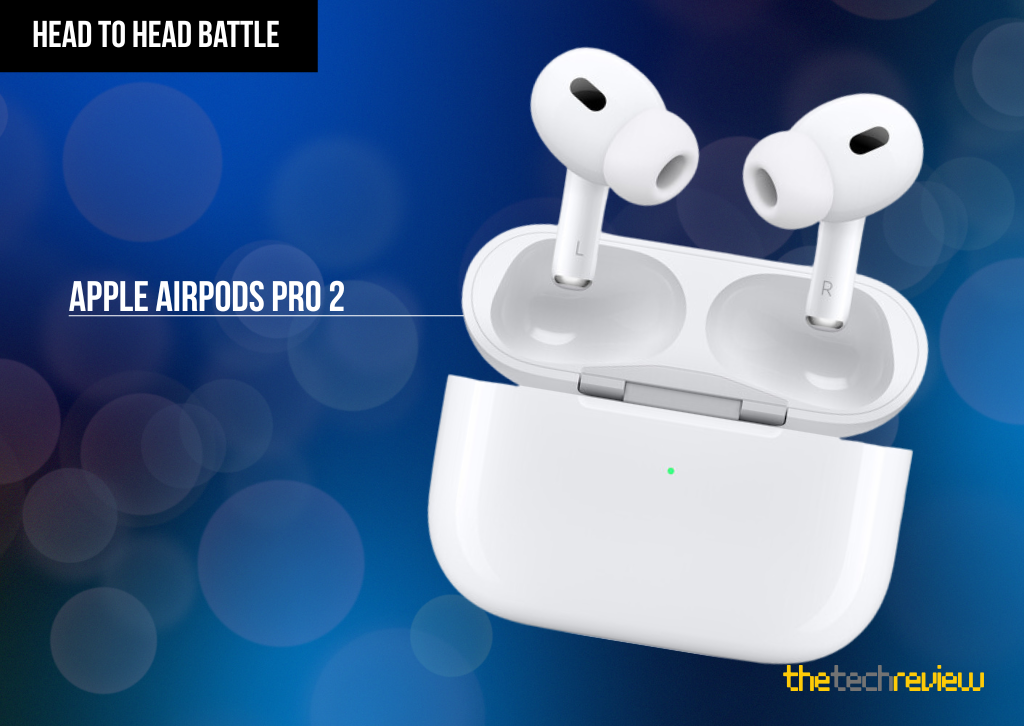
Bose Ultra Open Earbuds: Comfort is a major selling point for the Bose Ultra Open. Their lightweight, clip-on design makes it easy to forget you’re even wearing them. The absence of a tip in the ear canal eliminates the discomfort some people experience with traditional earbuds, making them perfect for all-day wear. They are secure enough for light activity but may not be the best choice for intense workouts in loud environments.- Apple AirPods Pro 2: The AirPods Pro 2 come with four sizes of silicone ear tips to ensure a snug fit. While this design is great for sound isolation and secure fit during exercise, some users may find them uncomfortable for prolonged periods. The fit is crucial for optimal ANC performance.
Ecosystem and Connectivity
- Bose Ultra Open Earbuds: The Bose earbuds are platform-neutral, working equally well on iOS and Android devices via the Bose Music app. They feature multipoint connectivity, allowing you to seamlessly switch between two connected devices.
- Apple AirPods Pro 2: Unsurprisingly, the AirPods Pro 2 are deeply integrated into the Apple ecosystem. They offer a “magical” experience with features like automatic switching between your iPhone, iPad, and Mac, hands-free Siri, and Precision Finding with the U1 chip in the case. For iPhone users, this seamless integration is a significant advantage.
Battery Life and Charging
- Bose Ultra Open Earbuds: You can expect up to 7 hours of playtime on a single charge (up to 4 hours with Immersive Audio enabled), with an additional 19.5 hours from the charging case. The case charges via USB-C but lacks wireless charging.
- Apple AirPods Pro 2: The AirPods Pro 2 offer up to 6 hours of listening time (5.5 with spatial audio) and up to 30 hours of total listening time with the MagSafe Charging Case. The case can be charged with a MagSafe charger, Apple Watch charger, or USB-C cable.
Price
- Bose Ultra Open Earbuds: The Bose Ultra Open Earbuds retail for around $299.
- Apple AirPods Pro 2: The Apple AirPods Pro 2 have a retail price of $249, though they can often be found for less.
Final Verdict
Choosing between the Bose Ultra Open Earbuds and the Apple AirPods Pro 2 comes down to your priorities and lifestyle.
- Choose the Bose Ultra Open Earbuds if… you value supreme comfort and situational awareness above all else. They are perfect for users who wear earbuds for extended periods while working, commuting, or walking and need to stay connected to their environment.
- Choose the Apple AirPods Pro 2 if… you are an iPhone user seeking the best all-around audio experience. Their superior noise cancellation, rich sound quality, and seamless integration with the Apple ecosystem make them the top choice for those who want an immersive and private listening experience.
Check out all our Head-to-Head Tech battles
Head to Head Battle
The Head-to-Head Battle: MacBook Air (M3) vs. Surface Laptop 7 (Snapdragon X series)

Apple Macbook Air vs Microsoft Surface Laptop 7
Both the MacBook Air with its M3 chip and the Surface Laptop 7, powered by Qualcomm’s Snapdragon X series (X Plus or X Elite), are strong contenders in the lightweight laptop market, offering a blend of performance, portability, and excellent battery life. However, they cater to slightly different preferences and excel in different areas.
Here’s a breakdown of their head-to-head battle:
1. Performance:
- MacBook Air (M3): Excellent for general productivity, web Browse, and even demanding tasks like photo and video editing (especially with Apple’s optimized software like Final Cut Pro). The M3 chip offers significant performance gains over older Intel Macs and even previous M-series chips for graphics-intensive tasks. It handles multitasking smoothly and quietly due to its fan-less design.
- Surface Laptop 7 (Snapdragon X Series): Microsoft has touted the Snapdragon X series as a direct competitor to Apple Silicon. Reviews indicate impressive performance for everyday tasks and even some creative applications. The Snapdragon X Elite, in particular, boasts a powerful Neural Processing Unit (NPU) for AI tasks, which can be a significant advantage for AI-driven workflows. However, app compatibility for ARM-based Windows can still be an issue for some specialized software, though it’s rapidly improving. In benchmarks, the MacBook Air generally shows stronger performance in tasks like Photoshop and video export.

2. Design and Build Quality:
- MacBook Air (M3): Known for its iconic, sleek, and premium aluminum unibody design. It’s incredibly thin and light. While the design remains largely the same as previous generations, it’s still widely praised. The notable design quirk is the display notch.
- Surface Laptop 7: Microsoft has refined the Surface Laptop design, making it look and feel very premium, often compared favorably to the MacBook Air. It’s also thin and light. The Surface Laptop 7 features thinner bezels, rounded display corners, and a larger haptic touchpad. It comes in various attractive colors.
3. Display:
- MacBook Air (M3): Features a Liquid Retina display (LED-backlit IPS) with a high resolution (e.g., 2560 x 1664 for the 13-inch) and 500 nits brightness. It offers excellent color accuracy and contrast. The refresh rate is 60Hz.
- Surface Laptop 7: Offers a PixelSense Flow Touchscreen with a 3:2 aspect ratio, available in 13.8-inch (2304 x 1536) and 15-inch (2496 x 1664) sizes. It boasts up to 600 nits peak brightness and a 120Hz refresh rate, providing a smoother visual experience than the MacBook Air, especially for scrolling and animations. It also has a touchscreen, which the MacBook Air lacks.
4. Keyboard and Trackpad:
- MacBook Air (M3): Features Apple’s Magic Keyboard, known for its comfortable typing experience and Touch ID for secure login. The Force Touch trackpad is industry-leading, offering precise control and haptic feedback.
- Surface Laptop 7: Offers a fantastic keyboard with a comfortable, soft yet premium feel. The haptic trackpad is highly praised as one of the best on a Windows laptop, almost rivaling Apple’s in precision.
5. Ports:
- MacBook Air (M3): Comes with two Thunderbolt / USB 4 ports (USB-C) and a MagSafe 3 charging port. Both USB-C ports are on the same side, which can be inconvenient for some setups. It supports one external display (or two with the lid closed).
- Surface Laptop 7: Features two USB-C (USB4/Thunderbolt 4) ports, one USB-A (3.2 Gen 2) port, a 3.5mm headphone jack, and a Surface Connect port for charging. The inclusion of a USB-A port is a definite advantage for legacy accessories, and the 15-inch model also includes a microSDXC card reader. It supports up to 3 external displays.
6. Battery Life:
- MacBook Air (M3): Known for its exceptional battery life, often achieving 15-18 hours of typical usage or video playback.
- Surface Laptop 7: Reviews indicate excellent battery life, with some users reporting 17-20 hours on a single charge for light to moderate use, thanks to the efficiency of the Snapdragon X chips. This puts it in direct competition with the MacBook Air.

7. Operating System and Ecosystem:
- MacBook Air (M3): Runs macOS, which offers a highly refined user experience, tight integration with other Apple devices (Continuity features, iPhone Mirroring), and a robust app ecosystem. Apple Intelligence is a new feature set coming to macOS.
- Surface Laptop 7: Runs Windows 11 Home (upgradeable to Pro), offering a familiar and versatile computing environment. It heavily features AI capabilities with Copilot+ PC features like Recall, Cocreator, and Windows Studio Effects. The main consideration is the ARM-based Windows, which, while improving rapidly, might still have compatibility issues with certain older or niche applications.
8. Price and Value:
- Both laptops generally start around $999-$1,000 for their base configurations.
- MacBook Air (M3): Offers a strong value proposition, especially for those invested in the Apple ecosystem. However, Apple’s RAM and storage upgrades can be quite expensive.
- Surface Laptop 7: Is competitively priced. A key advantage for the Surface Laptop 7 is that its SSD is user-removable and potentially upgradeable, unlike the MacBook Air’s soldered storage.
Conclusion:
The choice between the MacBook Air M3 and the Surface Laptop 7 largely comes down to personal preference and specific needs:
- Choose the MacBook Air M3 if:
- You are already deeply invested in the Apple ecosystem and prefer macOS.
- You prioritize consistent, silent performance with strong software optimization for creative tasks (especially Adobe apps).
- You value industry-leading trackpad feel and overall polish.
- You don’t need a touchscreen or a wide variety of ports.
- Choose the Surface Laptop 7 if:
- You prefer the Windows operating system and its broader software compatibility (though with a caveat for ARM-based apps).
- You desire a touchscreen and a higher refresh rate display.
- You need a USB-A port or a removable SSD.
- You are interested in the latest AI features offered by Copilot+ PCs and a strong NPU.
- You want a more open platform for hardware upgrades (storage).
Both are excellent, premium thin-and-light laptops. The Surface Laptop 7 represents a significant leap forward for Windows on ARM, putting it in a stronger competitive position against the established MacBook Air. Sources
-

 Photography3 months ago
Photography3 months agoSony FE 16mm f/1.8 G Review: The Ultra-Wide Prime for the Modern Creator
-
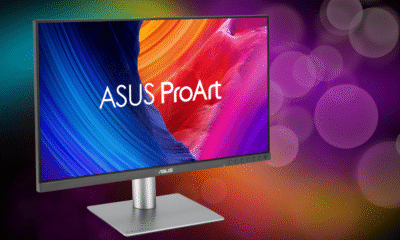
 Computers3 months ago
Computers3 months agoAsus ProArt Display 6K PA32QCV Review: A Visual Feast for Professionals
-

 Tablets5 months ago
Tablets5 months agoClash of the Titans: 13″ iPad Pro M4 vs. Samsung Galaxy Tab S10 Ultra – Which Premium Tablet Reigns Supreme?
-

 Home Tech3 months ago
Home Tech3 months agoThe Guardian of Your Threshold: An In-Depth Review of the Google Nest Doorbell
-

 Computers4 months ago
Computers4 months agoASUS Zenbook Duo: A Pretty Awesome Dual-Screen Laptop
-

 Photography4 months ago
Photography4 months agoAdobe’s “Project Indigo” is the iPhone Camera App We’ve Been Waiting For, and It’s Awesome
-

 Photography3 months ago
Photography3 months agoDJI Osmo 360 go: The Next Generation of Immersive Storytelling?
-

 Health Tech3 months ago
Health Tech3 months agoLumen Metabolism Tracker: A Deep Dive into Your Metabolic Health
-

 Computers4 months ago
Computers4 months agoApple Mac Studio Review: A Desktop Powerhouse Redefined
-

 Home Tech3 months ago
Home Tech3 months agoRevolution R180 Connect Plus Smart Toaster: More Than Just Toast?
-

 Computers4 months ago
Computers4 months agoSamsung 15.6” Galaxy Book5 360 Copilot AI Laptop: A Deep Dive into the Future of Productivity
-

 Buying Guides4 months ago
Buying Guides4 months agoThe Ultimate Workout Soundtrack: The Best Wireless Headphones for Your Fitness Journey










